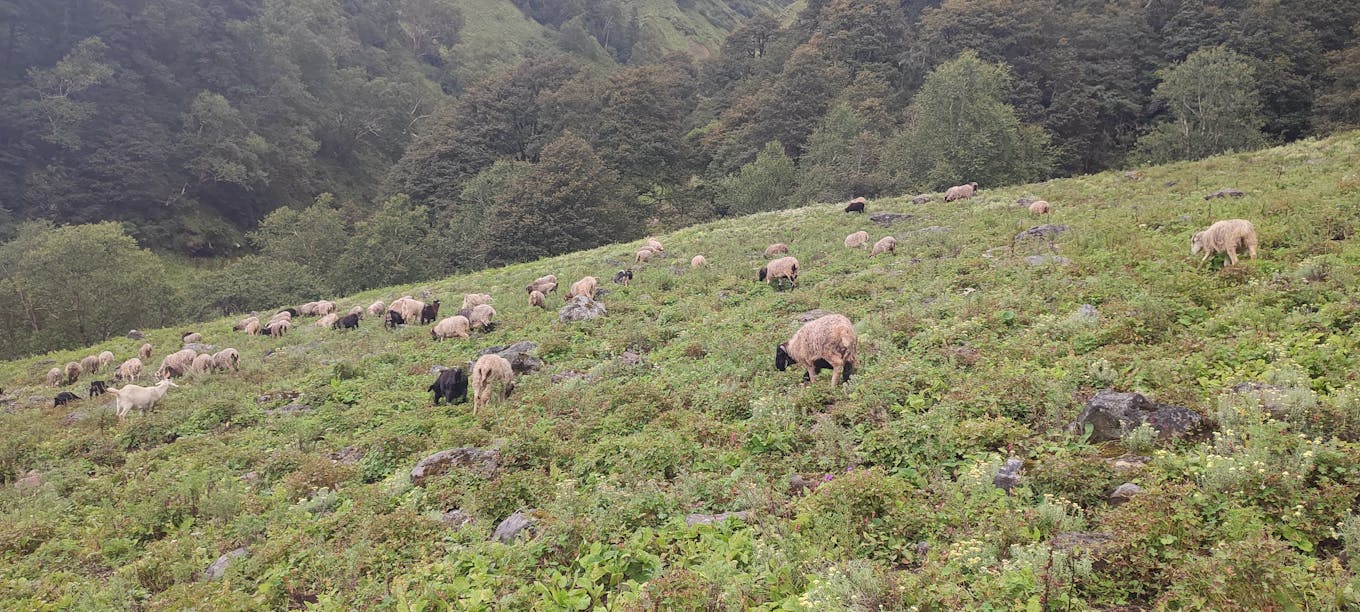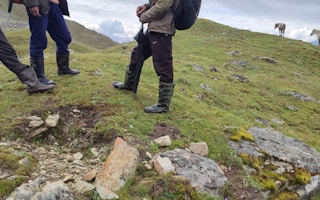Shankar Nepali, a resident of Lum, located in one of the rural municipalities of Jumla district in West Nepal, had recently bought 20 sheep with borrowed money worth Rs.250,000 (US$1,930). The sheep rearer had been planning to sell some sheep this Dashain, a 15-day harvest festival that is celebrated across the country and held from September to October each year, so that he could pay off the interest on his purchase, and have some leftover money to spend. But a lightning incident on 1 July ruined his plans.
“I was planning to sell five goats and buy some groceries, but now my entire shed is empty,” said Nepali, who has had sleepless nights since his loss. “How wilI I pay off the loan now?”
When the lightning occurred, Nepali had taken refuge under a tent in the meadows along with other shepherds. He recalls that it had started to rain heavily around 1 pm on that fateful day, and after an hour of rain, thunderous lightning struck, lighting up the fields for a second.
Then came darkness. “We all fainted. When we came to our senses half an hour later, we saw that the sheep had fallen to the ground,” Nepali said.
For another sheep rearer Ram Bahadur Reule, 50 sheep were killed and over 100 went missing when that same lightning striked Patarasi, Jumla. Suk Reule, Ram Bahadur’s son said that his father was deeply affected by the incident. “He did not speak with anyone for days. The sheep were the only property we had.”
Within Jumla, Patarasi has the highest number of sheep rearers. Total sheep numbers are at about 30,000, according to an estimate by the chief of the Animal Husbandry department in the municality. However, due to lightning strikes that have become a more frequent occurence, residents like Ram Bahadur and Nepali have sufferred cattle and sheep losses, which in turn have affected their livelihoods.
Sheep rearing and agriculture form the source of income for the people of the rural municipality which has a wide expanse of land. The municipality has a population of 19,000 people and 3,300 households.

Grazing sheep on a meadow in Jumla, Nepal. Image: Mukesh Pokharel
According to Dhan Bahadur Budha, an officer at the District Veterinarian’s Office, a sheep usually sells for between Rs20,000 and Rs30,000, but the price of sheep has also increased from last year. This makes the loss of the sheep rearers even dearer.
According to the official death toll calculated by the Patarasi rural municipality, 130 sheep were killed by the lightning strike in July, though villagers say the numbers could have been higher, at 300. The office has kept records since three years ago as farmers had asked for compensation for killed cattle and sheep. In August 2020, 217 sheep had also been killed by a lightning strike in Patarasi’s Baghjale area, according to its record.
The following year in June, 81 sheep and goats were killed in Patarasi’s Bajeri Patan.
Informal estimates put the death toll since 2015 at 1,500.
Why always Baghjale?
Why do lightning strikes frequently occur in Baghjale? A study has yet to be conducted on this issue, although climate experts say that the incidence of lightning strikes have increased due to global warming and climate change.
Shreeram Sharma, associate professor of physics at Nepal’s Amrit Science Campus says that the rate of effect due to lightning, which includes death by lightning, increases 10- to 20-fold with an increase of 1 degree Celsius in temperature. According to the Department of Hydrology and Meteorology, Jumla has witnessed a yearly temperature rise of 0.052°C on average. This means that the district has seen an increase of 1°C in the past 20 years.
How does a lightning strike occur?
A lightning strike is a high-voltage electric current produced due to friction within clouds. Globally, there are three lightning strike hotspots: the middle region of Africa, the region between South and North Americas, and East Asia.
East Asian countries such as Indonesia, Singapore, and Malaysia are epicentres of lightning strikes. The Bay of Bengal also has a small region that is susceptible to lightning strikes, and it is what leads to lightning strikes in Nepal.
In Nepal, the Terai and Chure regions witness maximum lightning strikes because of high temperatures. As the temperature rises, hot air ascends towards the atmosphere. When the vapourised air meets obstruction around the northern hills, there is a disturbance in the atmosphere, which leads to lightning strikes.
April, May, June and July record the highest lightning strikes. While most lightning strikes usually occur between 12 noon to 4 pm, monsoon and post-monsoon periods witness most lightning strikes at night.
According to Dr Indira Kandel, senior meteorologist at Nepal’s Department of Hydrology and Meteorology, the temperature rise in Jumla is substantial and expected to “create havoc in its ecology”.
Experts say that a lightning strike can be foretold half an hour before the strike, which gives sufficient time for farmers to evacuate their cattle and sheep. “Censors detect clouds that are susceptible to lightning strikes,” Sharma said. “We can minimise the risks if censors are put up in risk areas and farmers are given early warning.”
According to the National Disaster Risk Reduction and Management Authority, there are plans to set up early warning systems in places where there are risks of lightning strikes. The authority says this minimises the risks as the farmers receive warnings in advance.
Insufficient compensation
The Karnali provincial government and the Patarasi rural municipality have been providing compensation to farmers who lose their sheep. However, farmers say that the compensation is insufficient compared to their losses.
According to Dan Bahadur Bista, information officer at the Patarasi rural municipality, guidelines instituted in 2020 allow for a compensation of Rs.2,000 (US$15.40) per sheep.
The Karnali provincial government pays slightly more, at Rs.4,000 (US$30.80) per sheep. Purna Singh Bohora, the chairperson of the rural municipality, agrees that the compensation is not enough. “We are trying to look for long-term solutions,” he said.
According to Bohara, installing an early warning system or ‘earthing’ to reduce the lightning risks are technologies the rural municipality cannot afford. The municipality is in talks with the United Kingdom Government’s Nepal Climate Support Program to see if they can help support the installation of an earthing system in the meadows, he said.
Political apathy
The issue, being quite technical and scientific, has also failed to attract the attention of political parties. Major parties might have included climate change as something they want to deal with in their manifestoes, but there is general apathy towards the impact of lightning strikes on farmers’ livelihoods, said local leaders.
Gauri Nanda Acharya, a local leader of the Nepali Congress and the chief of the District Coordination Committee said: “We also cannot stop lightning strikes by making it an electoral issue. We need to focus on the losses that people are bearing.”
There is a need to implement an effective sheep insurance program to support the farmers, experts say.
According to Anil Pokharel, chief executive officer of the National Disaster Risks Minimisation and Management Authority, an insurance programme in place now does not reach the targeted farmers.
Pokharel believes that in Nepal, it is impossible to deal with issues related to a natural disaster without the commitment and involvement of political parties. “It should become a political issue if we are to secure the achievements we have made in the past 20 years,” he said.
The government currently has no data on the financial loss due to lightning strikes, but there is proof that it is lethal, beyond killing animals. According to a study by a team including academic Sri Ram Sharma, 930 individuals were killed in lightning strikes between April 14, 2011, and April 15, 2020. This means that almost 103 individuals die each year due to lightning strikes. In the same period, 2,454 individuals have been wounded in lightning incidents. An analysis of the data shows that among all natural disasters, lightning incidents in Nepal cause the highest number of deaths.
This article was first published on CIJ Nepal. It has been edited for clarity and brevity.










